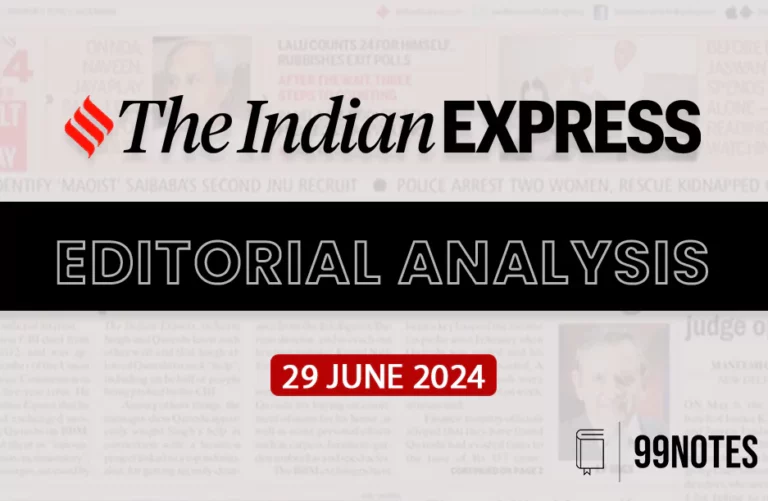06 May 2025: The Hindu Editorial Analysis
1. Messaging from holding the Indus Waters Treaty in ‘abeyance’
(Source – Page 10, The Hindu International Edition)
| Topic: GS Paper II – International Relations (India-Pakistan Relations, Treaty Obligations) GS Paper III – Internal Security (Cross-Border Terrorism, Strategic Resources) |
| Context |
|
Background:
-
Indus Waters Treaty (IWT), 1960: A water-sharing agreement between India and Pakistan brokered by the World Bank.
-
The recent decision to hold the treaty in “abeyance” is unprecedented, with strategic and legal dimensions.
Legal Concerns:
-
“Abeyance” has no formal recognition in IWT or the Vienna Convention on the Law of Treaties (VCLT).
-
India is not a party to the VCLT, but customary international law discourages unilateral treaty suspensions.
-
Articles XII (3) and (4) of IWT prohibit unilateral suspension.
Strategic Dimensions:
-
Seen as a political signal to deter Pakistan’s terror support.
-
India may pause sharing hydrological data and approval of infrastructure projects.
-
The decision may boost domestic infrastructure building on western rivers.
Risks:
-
International legal backlash or arbitration from Pakistan.
-
Environmental impact in the seismically sensitive and biodiversity-rich Indus Basin.
-
Weakening of India’s image as a law-abiding power.
Conclusion/Way Forward:
-
India must align its strategy with long-term geopolitical, ecological, and legal considerations.
-
Abeyance should not be a substitute for a comprehensive diplomatic and counter-terrorism strategy.
| Practice Question: Critically examine the legal, strategic, and environmental implications of India placing the Indus Waters Treaty in ‘abeyance’. Can water be used as a tool of strategic deterrence? (250 words) |
2. Cast of Characters
(Source – Page 10, The Hindu International Edition)
| Topic: GS Paper II – Governance (Caste Census, Reservation Policy) GS Paper I – Indian Society (Caste and Social Structure) |
| Context |
|
Key Background:
-
For the first time since 1931, caste may be recorded in the decadal census.
-
The 2011 SECC (Socio-Economic and Caste Census) was fraught with classification issues, identifying over 46 lakh castes.
Rationale for Caste Census:
-
To evaluate the distribution and access to reservation benefits among SCs, STs, and OBCs.
-
Can help implement sub-categorization within these groups to ensure equitable access.
Legal Developments:
-
Supreme Court upheld the idea of sub-categorization (Aug 2024 judgment).
-
Justice G. Rohini Commission studied OBC sub-categorization; report not made public yet.
Challenges:
-
Lack of standard caste classification mechanisms.
-
Risk of political misuse and data inflations.
-
May deepen social fragmentation if not handled carefully.
Conclusion/Way Forward:
-
Build national consensus and develop a scientific classification method.
-
Use the data for developmental purposes, not for political appeasement.
-
Transparency, data protection, and awareness campaigns are essential.
| Practice Question: “Caste Census can be a tool for inclusive governance but also a source of political and social tension.” Discuss the merits and demerits of conducting a full-scale caste census in India. (250 words) |
3. Maritime Hub – The Vizhinjam Port offers enormous economic benefits for India
(Source – Page 10, The Hindu International Edition)
| Topic: GS Paper III – Infrastructure (Ports, Energy) GS Paper II – Governance (Centre-State Relations in Infrastructure) |
| Context |
|
Project Highlights:
-
India’s first semi-automated deepwater port with 20m natural draft.
-
Strategically located on the east-west shipping axis.
-
Capable of handling ultra-large container ships without deviation.
Economic Significance:
-
Will reduce dependence on foreign transshipment hubs like Colombo, Salalah.
-
Potential to save India ~$200 million annually.
-
Boost to local economy, employment, and export competitiveness.
Challenges:
-
Resistance from fishing communities and Church groups.
-
Environmental and displacement concerns.
-
Need for timely completion of road and rail connectivity.
Way Forward:
-
Balance development with ecological safeguards.
-
Expedite hinterland infrastructure for maximum utility.
-
Address community concerns through rehabilitation and engagement.
| Practice Question: Analyze the strategic and economic significance of Vizhinjam Port for India’s maritime logistics. What are the key challenges in operationalizing such infrastructure projects? (250 words) |
Read more – 05 May 2025: The Hindu Editorial Analysis



